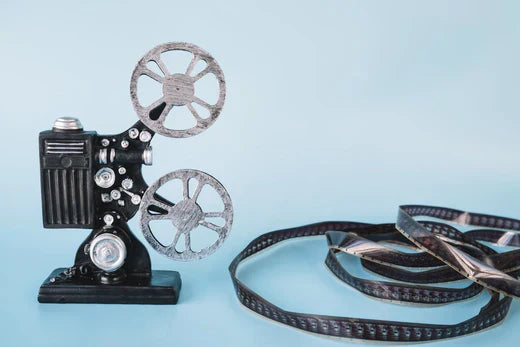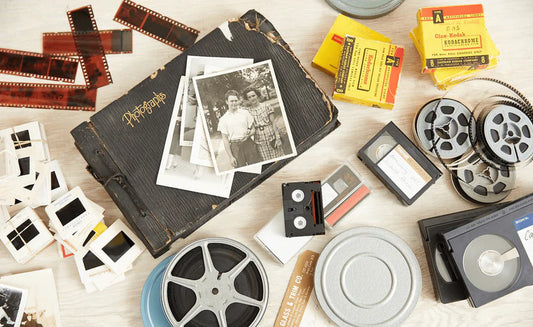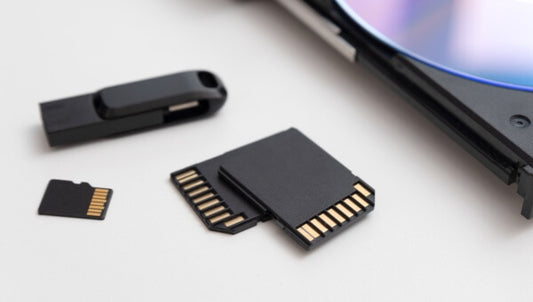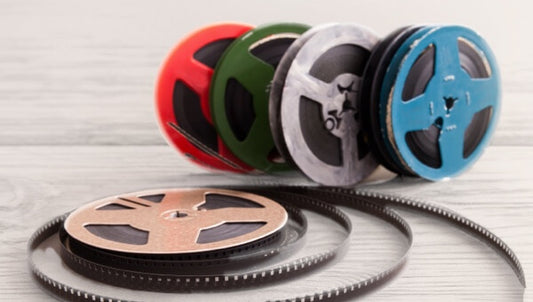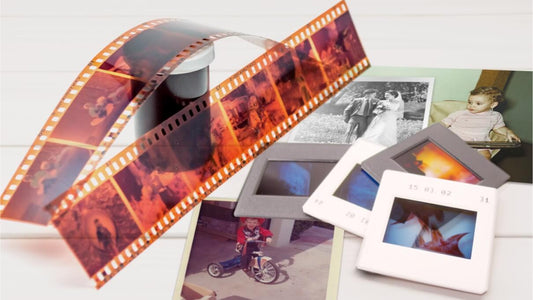8mm film formats, including Super 8 film, were an affordable and preferred way to capture home movies for decades. However, there are some significant differences between standard 8mm film and Super 8 film that matter if you want to view your precious memories captured on old film reels. Capture has been helping families view, share, and preserve film memories in high-quality digital format for over 20 years, which is exactly why we wanted to provide you with a comprehensive guide to show you the differences between Super 8 vs 8mm. That way, you can make sure you have the right 8mm projector for the type of film you have.
Keep reading to learn all about 8mm film and Super 8 film and the differences between them like the size, perforations, image quality, cost, and more, as well as how to play both film types.
Jump to:
-> Differences Between 8mm and Super 8 Film
-> Playing Both 8mm and Super 8 Film
What is 8mm Film?
In 1932, standard 8mm film was released by Eastman Kodak as an affordable alternative to 16 mm film. 8mm film has two times as many perforations, or sprocket holes, as the 16mm film format. It began as “double 8” film because it looked similar to a 16mm spool but had two sides that you could turn over.

The double-sided film stock made it more convenient for capturing longer memories. Then, when you had it processed, the lab would split the reversal film down the middle, splice each side of the film together, and provide you with an almost seamless home movie.
8mm cameras and film are lighter, cheaper, and less cumbersome than the larger film 16mm format. In fact, despite the names, 16mm is four times larger than 8mm film. Plus, not long after the double 8mm format was released, Bell & Howell developed and released a pre-split type of 8mm film. This made it even more compact and useful for movie-making at family gatherings with ease.
What is Super 8 Film?
Super 8 film was introduced in 1965 and became the go-to option for amateur filmmaking and home movies. Using Kodak Instamatic Movie Cameras, Super 8mm film made it easier to capture memories because the film reels were contained in a cartridge that reduced jamming, eliminated manual threading, and provided the opportunity to shoot an entire film spool without stopping.
Super 8 film cameras also offered more features than older 8mm models like various lenses, built-in filters, and zoom lenses. Plus, Super 8 film offered a rust-colored magnetic strip on the side that could record sound without any need for additional audio equipment.
While Super 8 Ektachrome film was briefly discontinued, the motion picture format is so popular among film archival enthusiasts that Kodak released it, which means you can still buy new Super 8 film. Compared with videotape cassettes, Super 8 film also lasts longer.

History and Cultural Significance of 8mm and Super 8 Film
8mm and Super 8 film were more than just a way to capture home movies - they were a revolution in personal filmmaking. Before the rise of digital video, these formats allowed families to record birthdays, vacations, and life milestones, preserving memories in a way that was never before possible. Home movie nights became a cherished tradition, where families would gather around a projector to relive special moments.
Beyond home use, Super 8 film played a crucial role in independent filmmaking. Many legendary directors, including Steven Spielberg and J.J. Abrams, got their start making short films with Super 8 cameras. Spielberg famously shot his early war films on Super 8, and Abrams later directed a film titled Super 8, paying tribute to the format’s nostalgic and creative influence.
Today, while digital video has taken over, 8mm and Super 8 film remain popular among film enthusiasts and collectors who appreciate the unique aesthetic of film grain and natural colors. These formats continue to be restored and archived, ensuring that historical footage from past generations is never lost.
How to Identify Your Film Without Equipment
If you have a box of old film reels but no measuring tools, you can still determine whether you have 8mm or Super 8 film using a few simple visual clues:
Look at the sprocket holes
- 8mm film: The sprocket holes are larger, rectangular, and positioned between frames.
-
Super 8 film: The sprocket holes are smaller, square-shaped, and centered inside each frame.
Compare using a household object
- Hold the film up to a sheet of graph paper or a standard pencil eraser:
- If the holes are almost the same width as the eraser, it’s 8mm film.
- If the holes are noticeably smaller, it’s Super 8 film.
Examine the image size
- If the image appears smaller and more compressed, it’s likely 8mm film.
- If it looks larger and more defined, it’s Super 8 film.
Check for a sound strip
- A rust-colored or brown magnetic strip on the edge of the film means it has sound.
- Most Super 8 films from the 1970s onward include this feature, while 8mm films rarely do.
By using these quick identification methods, you can determine which type of film you have without needing a projector or measuring tools.
Differences Between 8mm and Super 8 Film
As you can see, there are several differences when comparing 8mm film vs Super 8 including the number of sprocket holes, the picture quality, the length of home video, sound, and more.

Size of the film
While both are referred to as 8mm film formats, the size of the film frames is quite different. The width of both film types is the same, but the Super 8 film frame is close to twice the size of a standard 8mm film frame. The frame size on an 8mm reel is 4.5mm while a Super 8 reel is 5.79mm. This can be a quick way to see which type of film you have as long as you have a measuring tape or ruler to check the image area.
Shape and Location of Perforations on the Film
The shape of perforations or sprocket holes is one of the easiest ways to learn how to tell an 8mm reel vs super 8 reel. At first glance, the film types will look the same, but Super 8 sprocket holes will be more square and smaller while 8mm sprocket holes are larger, rectangular shaped, and horizontal. In addition, with Super 8mm film, the smaller sprocket holes will be centered on each frame whereas 8mm sprockets are located between frames.
Image Quality
When it comes to picture quality, Super 8 film is superior. That’s because the larger frame size can accommodate more detail. Plus, standard 8mm film does not respond as much to exposure, which means less vivid colors.
For similar reasons, Super 8 film offers an ISO of up to 500, which means it’s significantly better at filming in low-light situations. Finally, since Super 8 films are recorded at a higher frames-per-second than standard 8mm film (18 fps versus 16 fps), it will appear smoother and closer to what you’re used to in the digital age.
Availability and Cost
When it comes to availability and cost in 2025, Super 8 wins out again. Not only is new Super 8 film available from Kodak, but it’s also cheaper to find Super 8 equipment like a camera or projector. That being said, both can be affordable options depending on the purpose of the motion picture film. If you don’t care for sound or color, then black and white 8mm film can be an affordable option.
Length of Film Reel
When it comes to 8mm vs. Super 8, there are several film reel sizes available. The most typical film reel sizes range from 3” to 7”, which contain 50 to 400 feet of film. Likewise, the length of run-time is very similar. While the faster fps of Super 8 film may cause it to be a little shorter, you are typically looking at 3 to 4 minutes per 50 feet with both types of film.
Sound Recording
Most standard 8mm film does not record sound, but there are some types that do. If the film offers sound recording, it will have a brown strip down one edge. The same goes with Super 8 film, but Super 8 was much more likely to offer sound capabilities. In fact, almost all Super 8 films since 1973 can record sound. If you compare sound quality from both types of film, then Super 8 quality will be higher as well.
Compatibility with Projectors
You will have to have a dedicated film projector for each film type. For example, you will need an 8mm film projector to play your 8mm film reels.
Also, you need a Super 8 projector to play your Super 8mm film memories. There are also dual projectors that can play both types. The reason they are not cross-compatible is because of the differences in frame size, frame rate, sprocket size and location, sound capabilities, and other differences.
Playing Both 8mm and Super 8 Film
If you want to view your precious home movies that are captured on 8mm film formats, then you need to know how to do so. There are a couple of options you can choose to view or play 8mm or Super 8mm film.

Use a Projector
You can use a projector to view your film but remember that you will need a dual projector if you have both Super 8 and standard 8mm film. In addition, it can be a little hard to find a good projector these days, but if you do it can be a lot of fun to view memories as they were originally intended.
Viewing Table
While it won’t technically play your film as a home movie, a viewing table projects light through the film so that you can see the frames and the memories captured on them. This can make it hard to share those memories, but still lets you experience them. Plus, it doesn’t cost much and, unlike projectors, always works for both film types.
Film Transfer to Digital
Turning your Super 8 and 8mm film to digital format is a great way to preserve the home movies forever. Plus, it makes it easier to share them over social media and email, use editing software to enhance the picture quality, and more. Capture can transfer your film into high-quality digital format in less than 30 days and make sure your original film reels are safe and secure the entire time.

Convert Your Films to Digital and Preserve Your Memories
When it comes to 8mm vs Super 8, the main similarity is the width of the film. After that, there are tons of differences including sound capability, the shape of sprockets, frame rate, size, and overall picture quality. Once you identify the type of film you have, you can use a film projector to view it and enjoy the precious memories you captured long ago. Even if you prefer viewing your memories on a dedicated projector, we recommend you to digitize Super 8 movies first to ensure you never lose them. Capture offers affordable film transfer services to get your digital copies and original film reels back to you in 30 days or less.



